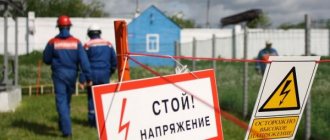Carrying out electrical work is a rather complex and dangerous procedure. Therefore, when performing such work, it is important to have the skills and experience to prevent emergency situations, violations of work technology and errors that can harm a person. Training, testing of knowledge in the field of electrical safety and obtaining an appropriate certificate by enterprise employees is a prerequisite for starting work, both for electrical and non-electrical personnel.
Categories of personnel in electrical safety
The main categories into which personnel are divided to obtain permission to work with electrical installations are:
- Electrotechnical;
- Electrotechnological;
- Not electrical.
Electrotechnological - personnel of production departments that work on electrical devices (electric ovens, electric welding, electrolysis and others), the work of which requires constant maintenance and adjustment of electrical equipment, electric drives, hand-held electrical machines, portable and mobile power receivers, portable power tools.
Non-electrical workers include workers whose activities involve interacting with various household appliances, simple electrical equipment and office equipment. Such workers are assigned electrical safety group I or II.
According to clause 1.4.1 of the PTEEP, the operation of electrical installations must be carried out by trained electrical personnel of the enterprise, who are divided into categories:
- administrative and technical;
- repair;
- operational;
- operational repair.
Administrative and technical
Specialists who organize the work process and manage the installation, configuration, maintenance and operation of electrical equipment.
Repair
Responsible for maintenance and repair of equipment, performs commissioning and commissioning.
Operational
Workers inspecting and monitoring electrical equipment perform prompt switching on, off, and switching of various electrical equipment in electrical installations. Responsible for permission to work in electrical installations.
Operational and repair
Personnel who monitor, maintain and repair electrical equipment that is assigned to this group;
Principles of training
Before performing work, electrical engineering personnel are trained. These procedures require training, which may vary depending on the category. Before carrying out their activities, it is imperative that appropriate training is carried out in place. This norm also applies if there is a break in activity of 1 year or more.
Electrotechnological personnel must undergo training. An electrical safety group is assigned after appropriate testing. The following activities must be performed:
- initial, introductory, repeated, targeted and unscheduled briefings;
- preparation for the profession - the internship lasts 2-14 shifts;
- checking the norms and regulations on security, industrial safety;
- special training;
- control training.
Specialists must have professional education to perform their activities efficiently. Over time, it is necessary to undergo retraining.
What and how many electrical safety groups are there?
In accordance with the PTEEP on electrical safety, five qualification groups are assigned for personnel interacting with and servicing electrical equipment.
Group I is established for non-electrical personnel who, in their activities, use power tools and equipment that do not require special training to work with them. This group is assigned to an employee of an enterprise who has at least electrical safety group III and higher.
Group II is assigned to workers servicing electrical devices and working on them. These include lifting machine operators, electric welders, and other specialists whose work involves the use and maintenance of portable electrical equipment employed on the territory of the enterprise. This group is also established for newly hired electrical personnel (electricians and others).
Group III is established for electrical personnel working in networks with voltages up to 1000 V and over 1000 V. Personnel with this group are allowed to independently service electrical installations and equipment, including its inspection, connection and disconnection.
Group IV is assigned to a person from among the engineering and technical workers who is responsible for electrical facilities up to 1000 V at the enterprise. Also, this group can be assigned to operational electrical personnel for training newly hired workers or those with little experience.
Group V is established for specialists (engineering engineers) who are responsible in the organization for electrical equipment over 1000 V. They can also supervise the production of electrical installation work and work on equipment up to 1000 V.
Specifics of briefings
Electrotechnological personnel undergoes:
- Instructions: primary, introductory - at the workplace, repeated, targeted, unscheduled on health and safety.
- Preparation for a new profession/position with on-site training. The duration of such an internship is 2-14 shifts.
- Testing knowledge of norms, security rules (PTE, POT, PUE), industrial safety regulations and other documents to the extent required for the position.
- Duplication lasting 2-12 shifts.
- Special training.
- Control training (fire and emergency).
Electrotechnological personnel also receive additional professional education to improve their skills on a continuous basis.
What you need to know about obtaining an electrical safety clearance group
Each electrical safety group requires specific knowledge, skills and experience to work on electrical installations. Therefore, in order to obtain an ES group and permission to work, you must undergo training and obtain permission to work. There is a certain procedure for assigning an electrical safety group to an employee.
Group I is assigned after undergoing instruction on the rules of working on electrical equipment and providing first aid in case of electric shock.
Group II requires workers to have special knowledge about the structure and operating principle of electrical equipment, safe work when working with power tools, as well as the consequences of electric shock and ways to provide assistance to victims of this phenomenon.
Group III is assigned only to electrical workers who have worked for 1 to 3 months at the enterprise. Such an employee must have knowledge of the design and principle of operation and maintenance of equipment, be able to monitor the progress of electrical work, be able to identify malfunctions and safety violations, and also provide assistance to victims of electric shock.
Group IV is received by specialists who have worked for 3 to 6 months with a confirmed III group and who have secondary vocational or higher education. This employee must be able to monitor and manage the production process, provide instructions, provide assistance, and also have serious knowledge in the field of maintenance, repair and operation of electrical installations for various purposes.
Group V is assigned to a specialist who has worked with Group IV from 3 months to two years, must know electrical installation diagrams, rules for using protective equipment and checking them, and operating rules for equipment. Also, an applicant for this group must be able to organize and manage work on electrical equipment with any voltage, be able to train personnel in labor safety rules, practical methods of providing first aid to victims at work, and be able to practically provide it.
Principles of training
Before performing work, electrical engineering personnel are trained. These procedures require training, which may vary depending on the category. Before carrying out their activities, it is imperative that appropriate training is carried out in place. This norm also applies if there is a break in activity of 1 year or more.
Electrotechnological personnel must undergo training. An electrical safety group is assigned after appropriate testing. The following activities must be performed:
- initial, introductory, repeated, targeted and unscheduled briefings;
- preparation for the profession - the internship lasts 2-14 shifts;
- checking the norms and regulations on security, industrial safety;
- special training;
- control training.
Specialists must have professional education to perform their activities efficiently. Over time, it is necessary to undergo retraining.
Additionally
Testing the knowledge of electrical and electrical engineering personnel is carried out by a commission. It is formed by order of the head of the enterprise. The commission must include at least five people. At the same time, its chairman must have group V at voltages above/up to 1000 V and IV at voltages only less than 1000 V. As a rule, he is the person responsible for the electrical part. When directly testing the knowledge of enterprise employees, at least 3 members of the commission must be present. In this case, the chairman must participate in the event. The presence of his deputy is allowed. Upon completion of the inspection, groups of electrical engineering personnel (II to V) are assigned. The corresponding mark is made on the certificate.
Who can provide training to such employees?
A responsible occupational safety specialist has the right to conduct training in an organization with non-electrical personnel.
As part of these events, employees are taught the basics of behavior in the event of emergency situations, the basics of legislation, safety precautions, rules for providing first aid and rules for handling equipment.
The types of briefings depend on the nature of the employee’s work and position, as well as the electrical safety category assigned to him.
A labor protection engineer must have the full range of knowledge in this field and regularly undergo advanced training in special training centers or educational organizations.
This specialist is appointed either from among the workers themselves or assigned to a separate position.
Instructions on electrical safety for non-electrical personnel can also be carried out by the director of an organization with a small number of personnel, while the director himself must have certain knowledge in this area.
Frequency of instructions
Considering the specific nature of the activity, the legislation does not strictly regulate the conduct of briefings in the field of electrical safety for non-electrical personnel.
However, the practice and recommendations of government supervisory authorities regulate the conduct of safety training at least once a year.
At the same time, the period of implementation can be reduced by coordinating this issue with the bodies of the trade union organization.
General requirements for employees
Employees must not only have professional qualifications, but also be divided into groups from 1 to 5. Before starting work, it is necessary to arrange instructions, before starting a shift, in the process of fulfilling their professional obligations and after their completion, each employee must comply with individual rules.
What electrical installations look like
Check of knowledge
It may be primary. Electrotechnological personnel consisting of new employees are subject to such testing. Another reason for its implementation is a break in certification lasting more than 3 years. The check may also be periodic. It, in turn, is divided into regular and extraordinary. In the first case, electrical engineering personnel are tested once a year if their tasks include:
- Direct organization and performance of maintenance work on existing electrical units.
- Carrying out installation, adjustment, repair, preventive testing.
A similar period is established for employees who have the right to issue orders, orders, and conduct operational negotiations. Administrative and technical personnel and occupational safety specialists authorized to inspect installations are inspected once every three years. Extraordinary certification is carried out regardless of the date of completion of the previous one in the following cases:
- When newly developed or revised rules and regulations are put into effect.
- When installing new equipment, changing/reconstructing main technological and electrical circuits. The expediency and necessity of conducting an extraordinary inspection is determined by the responsible person.
- When transferring/assigning to another job if the assigned duties require knowledge of an expanded list of rules and regulations.
- If employees fail to comply with the requirements of regulations on occupational safety.
- At the request of state supervision authorities.
- Based on the conclusion of the commission that investigated an accident involving people or disruptions in the functioning of a power plant.
- When upgrading your qualifications to obtain a higher group.
- If there is a break in activity in this position for more than six months.










